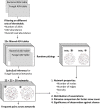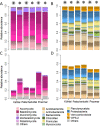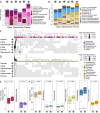Fungal and bacterial communities and their associations in snow-free and snow covered (sub-)alpine Pinus cembra forest soils
- PMID: 38566162
- PMCID: PMC10985912
- DOI: 10.1186/s40793-024-00564-7
Fungal and bacterial communities and their associations in snow-free and snow covered (sub-)alpine Pinus cembra forest soils
Abstract
Background: In Europe, Pinus cembra forests cover subalpine and alpine areas and they are of high conservational and ecological relevance. These forests experience strong seasonality with alternating snow-free and snow covered periods. Although P. cembra is known for mycorrhization and mycorrhizae usually involve fungi, plants and bacteria, the community compositions of fungi and bacteria and their associations in (sub-)alpine P. cembra forests remain vastly understudied. Here, we studied the fungal and bacterial community compositions in three independent (sub-)alpine P. cembra forests and inferred their microbial associations using marker gene sequencing and network analysis. We asked about the effect of snow cover on microbial compositions and associations. In addition, we propose inferring microbial associations across a range of filtering criteria, based on which we infer well justified, concrete microbial associations with high potential for ecological relevance that are typical for P. cembra forests and depending on snow cover.
Results: The overall fungal and bacterial community structure was comparable with regards to both forest locations and snow cover. However, occurrence, abundance, and diversity patterns of several microbial taxa typical for P. cembra forests differed among snow-free and snow covered soils, e.g. Russula, Tetracladium and Phenoliphera. Moreover, network properties and microbial associations were influenced by snow cover. Here, we present concrete microbial associations on genus and species level that were repeatedly found across microbial networks, thereby confirming their ecological relevance. Most importantly, ectomycorrhizal fungi, such as Basidioascus, Pseudotomentella and Rhizopogon, as well as saprobic Mortierella changed their bacterial association partners depending on snow cover.
Conclusion: This is the first study researching fungal-bacterial associations across several (sub-)alpine P. cembra forests. The poorly investigated influence of snow cover on soil fungi and bacteria, especially those mycorrhizing P. cembra roots, but also saprobic soil organisms, underlines the relevance of forest seasonality. Our findings highlight that the seasonal impact of snow cover has significant consequences for the ecology of the ecosystem, particularly in relation to mycorrhization and nutrient cycling. It is imperative to consider such effects for a comprehensive understanding of the functioning resilience and responsiveness of an ecosystem.
Keywords: Microbial association networks; Microbial interaction; Mountain forest soil; Mycorrhiza; Seasonality.
© 2024. The Author(s).
Conflict of interest statement
The authors declare that they have no competing interests.
Figures





References
-
- Casalegno S, Amatulli G, Camia A, Nelson A, Pekkarinen A. Vulnerability of Pinus cembra L. in the Alps and the Carpathian mountains under present and future climates. Forest Ecol Management. 2010;259(4):750–761. doi: 10.1016/j.foreco.2009.10.001. - DOI
-
- Vavrus S. The role of terrestrial snow cover in the climate system. Clim Dynam. 2007;29(1):73–88. doi: 10.1007/s00382-007-0226-0. - DOI
-
- Blankinship JC, Hart SC. Consequences of manipulated snow cover on soil gaseous emission and N retention in the growing season: a meta-analysis. Ecosphere. 2012 doi: 10.1890/Es11-00225.1. - DOI
-
- Zhao ZM, De Frenne P, Peñuelas J, Van Meerbeek K, Fornara DA, Peng Y, et al. Effects of snow cover-induced microclimate warming on soil physicochemical and biotic properties. Geoderma. 2022 doi: 10.1016/j.geoderma.2022.115983. - DOI
Grants and funding
LinkOut - more resources
Full Text Sources
